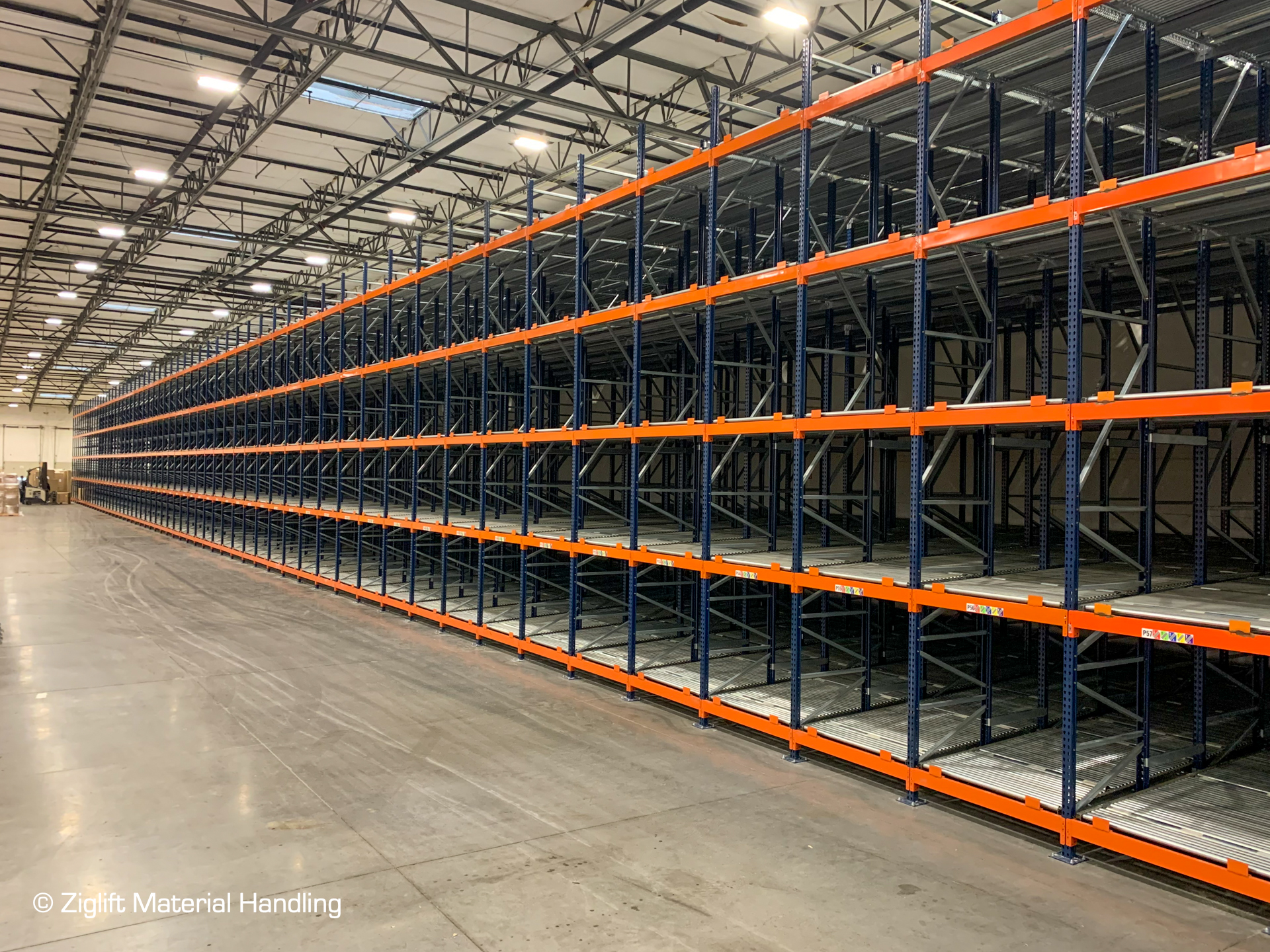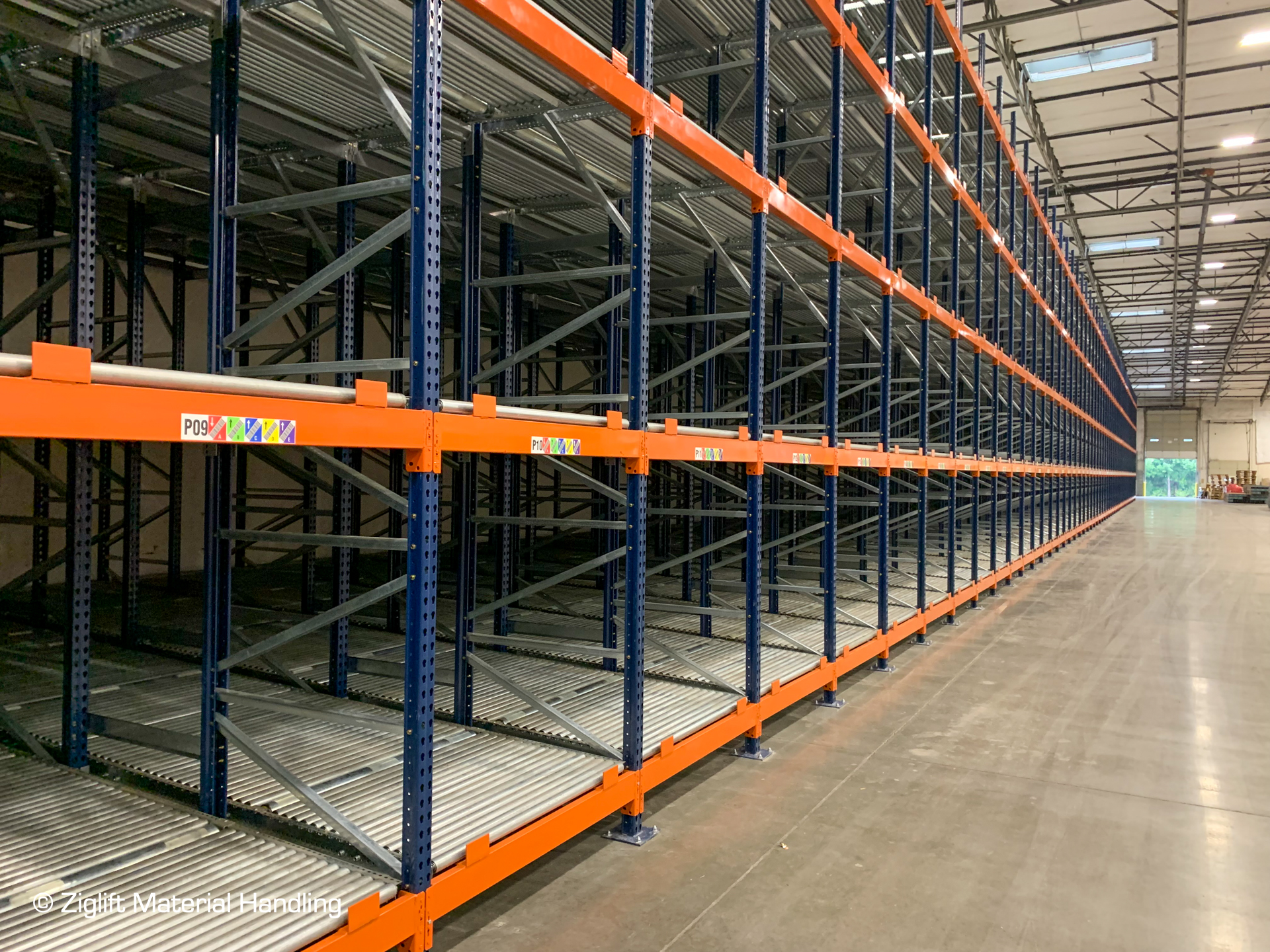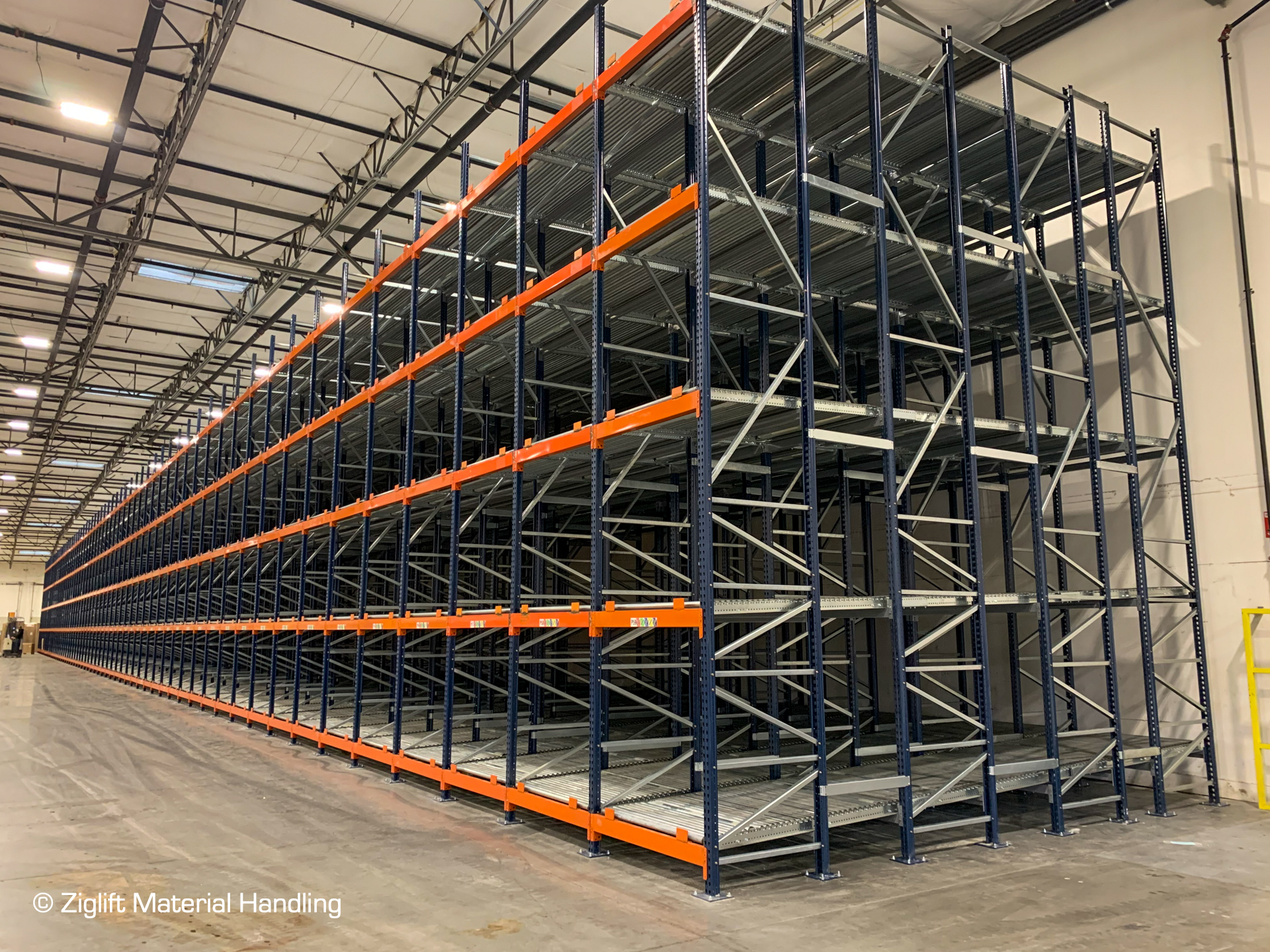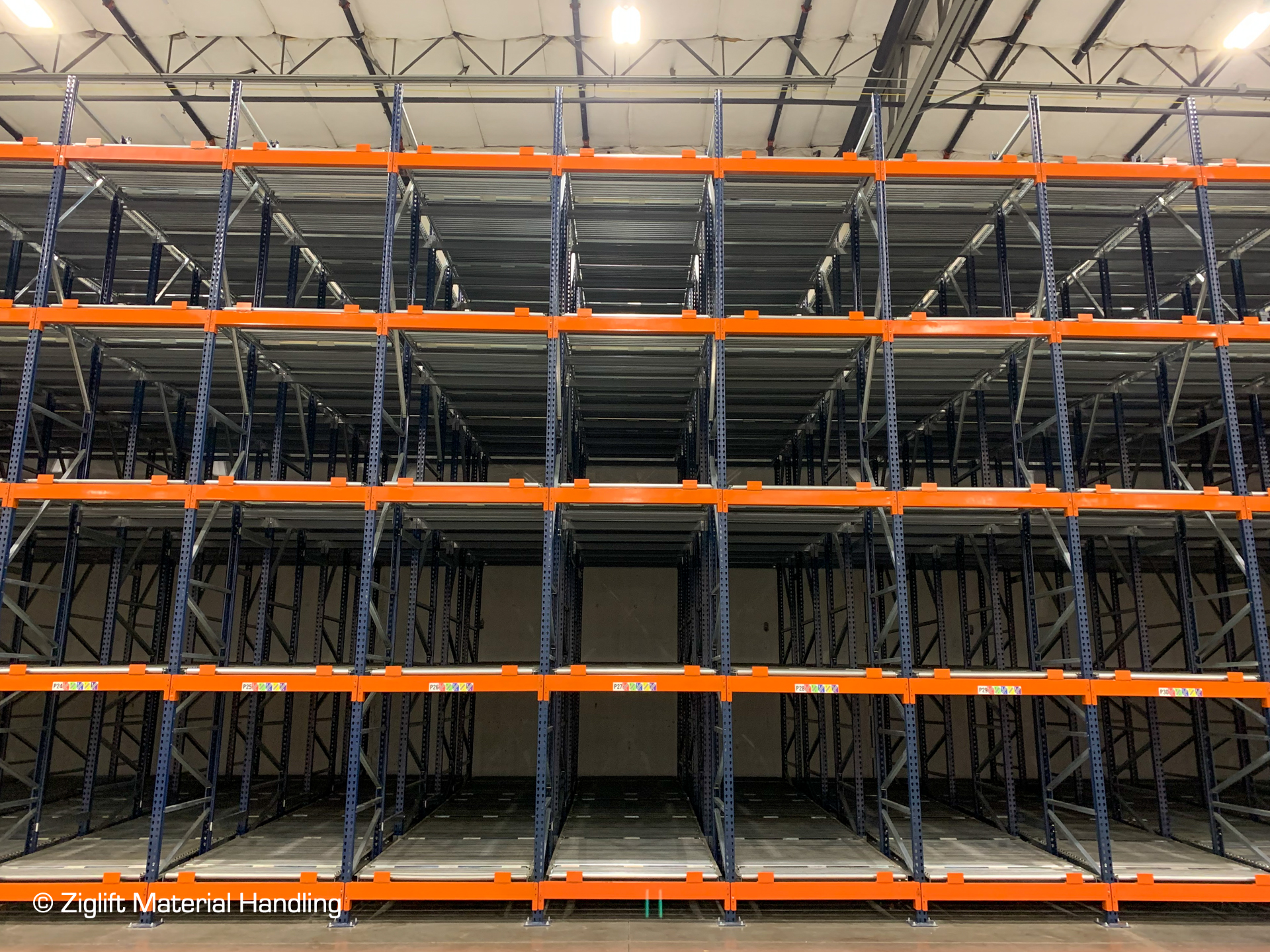


 Are you a warehouse manager looking for ways to maximize your warehouse space? There are a lot of options out there, but Pallet Flow Racking Systems could be the solution you need. Here are some reasons why:
Are you a warehouse manager looking for ways to maximize your warehouse space? There are a lot of options out there, but Pallet Flow Racking Systems could be the solution you need. Here are some reasons why:
- Pallet Flow Rack Systems are dynamic racking systems that uses the power of gravity to move palletized loads along flow rails.
- These systems are ideal for high-volume inventory with a moderate to low number of SKUs, making them a great option for food distribution and other industries.
- Pallet Flow Rack Systems offer higher storage density than conventional pallet systems, allowing you to store a high number of pallets in the available storage space.
- These systems also allow for inventory rotation based on the expiration date, as well as direct access to pallets from the loading aisle.
- By using pallet flow racking, you can minimize travel time for picking operations, as well as improve order picking efficiency.
But how do pallet flow rack systems work, and how do you choose the right one for your specific needs? In this article, we’ll dive into the details of these remarkable systems, including the different types of flow rails, support structures, and pallet stops, as well as the benefits and limitations of these systems.
I. Understanding Pallet Flow Rack
If you’re looking to maximize your warehouse space, then pallet flow rack systems might be the ideal solution for your specific needs. This type of racking is a dynamic racking system that uses the power of gravity to move palletized loads from the loading aisle to the picking aisle. This system is ideal for high-density storage systems where there’s a high number of pallets, a moderate number of SKUs, and high-volume inventory.
Here are some key features and benefits of pallet flow rack systems:
- Flow rails guide the pallets down the sloped plane towards the pick aisle. These rails are available in a wide range of materials, including plastic, steel, and aluminum, depending on your needs.
- Pallet stops are put at the end of the rack structure which ensures that the pallets come to a stop at the right position. This is especially important for LIFO systems where the last pallet in is the first pallet out.
- Higher storage density is much greater than conventional pallet racking system because the individual flow rates of the pallets can be controlled.
- Easy inventory rotation because the first pallet in is the first pallet out. This makes it easy to rotate inventory and monitor expiration dates.
- Improved order picking by reducing travel time and providing direct access to palletized loads.
- Infinite variety of layouts are available so you can customize the system to fit the size of your facility and the specific needs of your operation.
By understanding the basic features and benefits of pallet flow rack systems, you can make an informed decision about whether this dynamic flow system is the right fit for your warehouse storage and material handling equipment needs.
II. Key Features of Pallet Flow Rack System
Pallet Flow Racking Systems have become popular in the warehouse and distribution center industry due to their efficiency in maximizing space and optimizing inventory rotation. Here are some of the key features that make this system an ideal solution for high-volume inventory:
- Power of Gravity: The force of gravity to move pallets and cartons along flow rails. This reduces the need for material handling equipment, such as pallet trucks and forklifts, and speeds up picking operations.
- High-density storage: This kind of system can store a
high number of pallets, making it an efficient solution for those with limited space. This system allows for higher storage density and a larger storage capacity compared to conventional pallet racks.
- Inventory rotation: Pallet Flow Rack Systems promote inventory rotation, which helps reduce waste by allowing FIFO (first in, first out) or LIFO (last in, first out) systems. This is especially important in industries with expiration dates or perishable goods.
- Customizable: This type of system can be designed to fit the specific need of your warehouse, such as accommodating different pallet sizes, weight capacities, and the number of SKUs.
- Flexibility: The flexibility of this system allows for an infinite variety of layouts and can be easily adapted to fit different phases of the operation.
- Easy access: Direct access to the pallets is possible from the loading aisle, while the picking aisle is located on the other side of the rack, which reduces travel time and simplifies order picking.
By considering the key features of Pallet Flow Rack Systems, you can determine if it’s the right storage solution for your warehouse or distribution center.
III. Factors to Consider When Implementing Pallet Flow Rack System
When implementing a Pallet Flow Rack System, there are several factors that you should take into consideration. These factors can affect the overall efficiency and effectiveness of the system, and should not be overlooked. Some of the key factors to consider include:
- Inventory Characteristics: Consider the size, weight, and shape of your palletized loads. Ensure that the pallet flow rack system can accommodate your specific inventory requirements.
- Order Picking: Determine the frequency and process of order picking. Ensure that the flow of inventory through the system aligns with your order picking process.
- Space Requirements: Consider the available storage space and the size of your facility. Pallet flow rack systems can help maximize warehouse space by allowing for high-density storage, but you need to ensure that the system fits your space requirements.
- Load and Unload Process: Consider how the pallets will be loaded and unloaded from the system. Ensure that you have the necessary material handling equipment, such as pallet trucks or forklifts, to effectively manage this process.
- Safety Requirements: Ensure that the system meets all necessary safety requirements and regulations. safety features such as pallet stops and twist-lock carabiners should be installed to prevent accidents.
- Budget: Determine the overall cost of the system and ensure that it aligns with your budget. These systems can be a significant investment, but they can also provide significant long-term savings by improving efficiency and maximizing storage space.
By taking into account these key factors when implementing a pallet flow rack system, you can ensure that the system is tailored to meet your specific needs and requirements.
IV. Implementing Your Pallet Flow Rack System
Implementing a pallet flow rack system can be a complex process, but with careful planning and execution, it can be done effectively. Here are some key factors to consider when implementing a pallet flow rack system:
- Planning and Design: Before implementing a pallet flow rack system, it is important to have a detailed plan and design that takes into account the available space, the size and weight of the pallets to be stored, and the desired flow of materials.
- Installation: Proper installation is critical to the success of this system. It is important to follow manufacturer guidelines and use experienced installers to ensure the system is installed safely and correctly.
- Employee Training: Proper training is essential for the safe and effective use of this rack system. Employees should be trained on how to properly load and unload pallets, as well as how to operate the system safely.
- Maintenance: Regular maintenance is necessary to keep the pallet flow rack system operating effectively and safely. This includes regular inspections, cleaning, and repairs as needed.
- Continuous Improvement: As with any system, it is important to continuously monitor and evaluate it to identify areas for improvement and make adjustments as needed.
By considering these factors and working with experienced professionals, implementing a pallet flow rack system can help increase efficiency, improve safety, and optimize storage space in your warehouse or distribution center.
V. Inspection, Maintenance, and Safety of Pallet Flow Rack System
Ensuring the safety of your pallet flow rack system is crucial to maintaining an efficient warehouse operation. To achieve this, you need to perform regular inspections and maintenance of your system.
Here are some key points to consider:
- Inspection and Maintenance of Pallet Flow Rack: It’s essential to inspect and maintain your setup regularly to ensure that it’s in good working condition. Some components, such as the rollers and brakes, need frequent attention to keep the system functioning correctly.
- Repair and Replacement of Damaged Components: It’s also important to repair or replace any damaged components as soon as possible. Damaged components can cause the entire system to fail, leading to accidents, loss of product, and downtime.
- Safety Protocols for Pallet Flow Rack System: Establishing and enforcing safety protocols for your system is necessary to prevent accidents. Some essential protocols include placing warning signs, implementing proper storage techniques, and ensuring that forklift operators receive proper training.
- Importance of Regular Safety Training: Regular safety training is essential to minimize the risks associated with operating this system. Ensure that your employees undergo frequent training to ensure that they understand the risks involved and the best practices to follow.
In summary, maintaining the safety and efficiency of your pallet flow rack system requires consistent inspection and maintenance, prompt repair or replacement of damaged components, proper implementation of safety protocols, and regular safety training for employees. By doing so, you can prevent accidents, product loss, and downtime, ultimately improving your warehouse operation.
VI. Pallet Flow Rack Systems in Action
Pallet Flow Rack Systems have become increasingly popular in recent years due to their ability to optimize storage space, increase efficiency, and reduce costs. Let’s take a look at five use cases that demonstrate the effectiveness of pallet flow rack systems in different industries:
- Food and Beverage Industry: A major beverage company implemented a pallet flow rack system to store raw materials and finished goods. The system increased the storage capacity of the facility by 40% and reduced labor costs by 30%.
- Pharmaceutical Industry: A pharmaceutical company used these systems to store active pharmaceutical ingredients (APIs). The system helped reduce the risk of cross-contamination and improved inventory management, resulting in a 50% reduction in storage space and a 60% increase in picking efficiency.
- Automotive Industry: An automotive parts supplier implemented this system to store and manage small parts. The system improved picking efficiency by 70% and reduced product damage by 50%.
- E-commerce Industry: An online retailer implemented this system to manage its inventory of large and heavy items. The system increased storage capacity by 60% and reduced picking time by 50%.
- Distribution Industry: A logistics company used this system to store and manage high-volume items. The system helped increase storage capacity by 80% and reduce picking errors by 90%.









